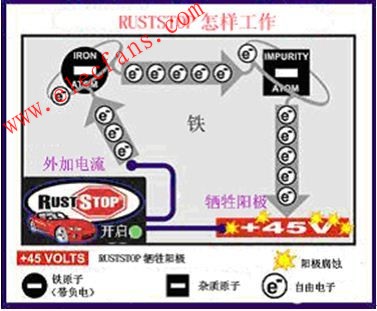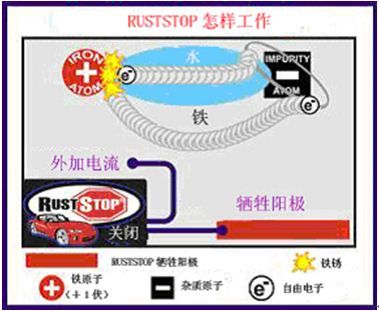Automotive electronic anti-rust system is an advanced automotive anti-rust technology that has appeared internationally in the last decade Will be damaged by rust, and can ensure that the main parts of the car will not affect performance due to rust.
Before understanding the automotive electronic anti-rust system, first look at what is the electronic anti-rust technology.

Electronic rust prevention technology is also called cathode corrosion protection technology. Cathodic protection technology is a kind of electrochemical protection technology. Its principle is to apply an applied current to the surface of the corroded metal structure, and the protected structure becomes the cathode, so that the electron migration that occurs in metal corrosion is suppressed, and the corrosion is avoided or reduced. occur. At present, cathodic protection technology has matured and is widely used in the corrosion control of metal structures such as steel pipes, cables, steel piers, ships, storage tank bottoms, coolers, etc. in soil, seawater, fresh water, and chemical media. 1834—Faraday → The foundation of the principle of cathodic protection 1890—Edison → Proposed mandatory current protection for ships 1902—Korn → Realized Edison ’s vision 1905—U.S. For boiler protection 1906—Germany established the first A cathodic protection plant in 1913-named electrochemical protection 1924-cathodic protection of underground pipe networks
The technology is divided into two types: sacrificial anode cathodic protection and forced current (impressed current) cathodic protection.
1) Sacrificial anode cathodic protection technology
Sacrificial anode cathodic protection technology is to use a metal or alloy with a potential that is more negative than the metal to be protected to electrically connect with the protected metal, relying on the current generated by the metal with a more negative potential to continuously corrode and dissolve to protect other metal. Advantages: A: The cost of one-time investment is low, and maintenance costs are basically not required during operation. B: The utilization rate of the protection current is high, and no over-protection occurs. C: No interference effect on the adjacent underground metal facilities, applicable For long-distance pipelines in the factory area and without power supply, as well as small-scale distributed pipeline protection D: It has the role of both grounding and protection E: The construction technology is simple, and no special professional maintenance and management are usually required. Disadvantages: A: Low driving potential and protection current regulation Narrow range and small protection range B: The use range is limited by the soil resistivity, that is, when the soil resistivity is greater than 50Ω? M, the sacrificial anode protection method is generally not suitable. C: In the presence of strong stray current interference areas, especially when AC interference The anode performance may be reversed C: Effective cathodic protection years are limited by sacrificial anode life and need to be replaced regularly
2) Forced current cathodic protection technology

Forced current cathodic protection technology is to connect a DC power supply in the loop, with the aid of an auxiliary anode, direct current is passed to the metal to be protected, and then the metal to be protected becomes a cathode for protection. Advantages: A: High driving voltage, can flexibly control the output of cathodic protection current in a wide range, suitable for occasions with a large protection range B: Suitable for harsh corrosion conditions or high resistivity environments : When insoluble or slightly soluble auxiliary anodes are selected, long-term cathodic protection can be carried out. D: The protection range of each auxiliary anode bed is large. When the quality of the pipeline anticorrosion layer is good, the protection range of a cathodic protection station can reach tens of kilometers. E: The complete cathodic protection can also be achieved for the bare or poor-quality pipelines: A: The one-time investment cost is relatively high, and electricity is required during operation B: During the operation of the cathodic protection system, strict professional maintenance management is required C: External power supply is necessary, and it is required to supply power for many years. D: It may cause interference to nearby underground metal structures.
The application of electronic anti-rust system in automobile anti-rust
Rothschild RUSTSTOP was the first to apply sacrificial anode and applied current technology to electronic anti-rust equipment at the same time. It has made great progress in cathodic protection technology through extensive testing and research, and has produced an improved version of cathodic protection. The electrolyte provides rust protection under atmospheric conditions. This technology-direct cathodic protection (DCP)-cleverly combines sacrificial anode technology and applied current technology, does not rely on electrolyte (water) to provide a path for free electrons to flow to the anode, but adds a current to the protected On the device, electrons are forced to flow through the metal to the positively charged anode. The anode is corroded (sacrifice), and the corrosion (rust) process is blocked, so the car is protected.
The current for controlling metal rust changes with the change of the environmental humidity. If moisture is sensed, the risk of rusting increases and the system will inject more current to provide stronger protection. The instrument outputs a positive charge of 45 volts to the anode. This high voltage makes the electrons more attractive, thus providing stronger rust protection.
In addition to direct cathodic protection, these systems also use the traditional form of cathodic protection under humid conditions or high atmospheric humidity or salty conditions. Even the dirt and dirt on the device are electrically conductive, so electrolytes can be formed to make traditional cathodic protection effective. The use of Roche-Doup electronic anti-rust system can protect the car under dry or wet conditions.
How does RS-5 work?
The RUSTSTOP RS-5 (formerly Rust Stop RS2000) electronic antirust device successfully combines the applied current and sacrificial anode technology, effectively overcoming the limitations of "traditional cathodic protection" and preventing the occurrence of automotive rust. Rust is essentially an electrochemical process. The RustStop RS-5 system acts like a "rust magnet", absorbing electrons that would otherwise rust the car. Then RustStop "corroded magnet" is corroded, not your car is corroded, let you see for yourself that the system is preventing rust!
This chart shows that the RustStop system is shut down. It can be seen that free electrons react with iron atoms to generate rust. Sacrificial anodes: When RustStop is installed, four sacrificial anodes, called "corroded magnets" (corroded polar plates), are distributed in an orderly manner and connected to the parts of the car where water flows easily gather or pass.
When the RustStop system is turned on, the system command module applies a positive charge of 45 volts to the corroded plate (sacrificial anode) to make the iron and impurity atoms negatively charged relative to the corroded plate. Free electrons are attracted through the iron to the 45-volt positively charged rusty plate instead of negatively charged iron atoms. When free electrons reach the corroded plate, the plate is corroded (sacrificed). This means that if there is no RustStop electronic anti-rust device, the corrosion formed on the corroded plate will appear on a certain part of the car.
The corrosion of the RustStop plate (sacrificial anode) allows you to see for yourself that the system is preventing rust.
Note: The function of the RustStop RS-5 electronic anti-rust device is very good, because the output voltage on the corroded pole plate is increased stepwise to 45 volts, which can cause a large gap between the car and the corroded pole plate. The voltage difference makes the corroded polar plate attractive to free electrons extremely powerful, and the whole system works very effectively. Applied current: The effect of the applied current is that the free electrons in the car metal are controlled by the applied current released by the Roche-Doup RustStop RS-5 command module. The weak attraction of iron atoms to free electrons is blocked by a strong uniform electron flow (applied current) flowing through the body metal. In short, the continuous flow of electrons in the metal prevents free electrons and iron atoms from reacting to form rust. Roche-Doup RustStop RS-5 adopts the dual technologies of sacrificial anode and applied current, which is currently the most effective automotive electronic anti-rust system.
Rental LED display screens
LED technology is the latest and the best in terms of the audio visual technologies out there and it is still evolving. There is a strong emphasis in making LED displays energy efficient, cost efficient and light weight apart from other quality requirements. Hence, LED cabinets are also now expected to be lighter in weight. This need has resulted into the gradual shift from the iron cabinet, aluminum cabinet, to the cast-aluminum and die cast aluminum as the weight of the cabinet is lighter. Cast aluminum and die cast-aluminum cabinets are the latest of the cabinets used for LED casing.
The cast aluminum and die cast-aluminum cabinets have high strength and high tenacity. They are highly efficient, provide excellent heat dissipation, energy conservation and environmental protection. Because of their outdoor usage, they can be made as a waterproof cabinet of leasing cast aluminum. They are lightweight and ultrathin. They are quite flexible for easy packaging and lifting. They have a high refresh rate, high grayscale and are widely applied to the stage renting. They are easy and simple to install and thus help you save on precious time and man power as one-person can easily do the insallation. Cabinet splicing and wiring connection is fast and reliable. Not only great in looks dept. it can be easily dismantled. Casting Aluminum and die Casting Aluminum Cabinet also have better deformation resistance property.
Rental Led Display,Rental Led Screen,Led Video Wall,Led Screen Rental
Shenzhen Priva Tech Co., Ltd. , https://www.privaled.com